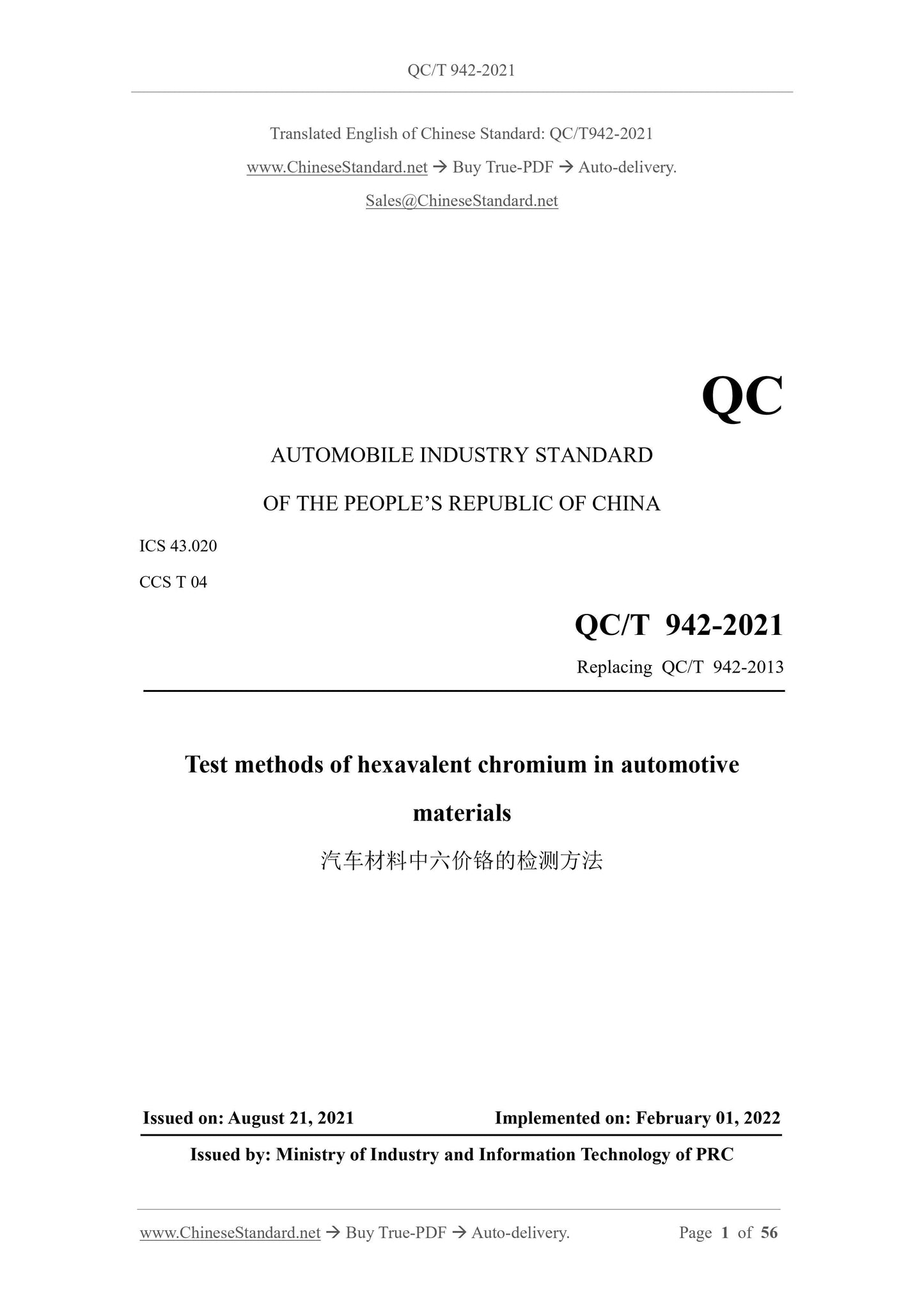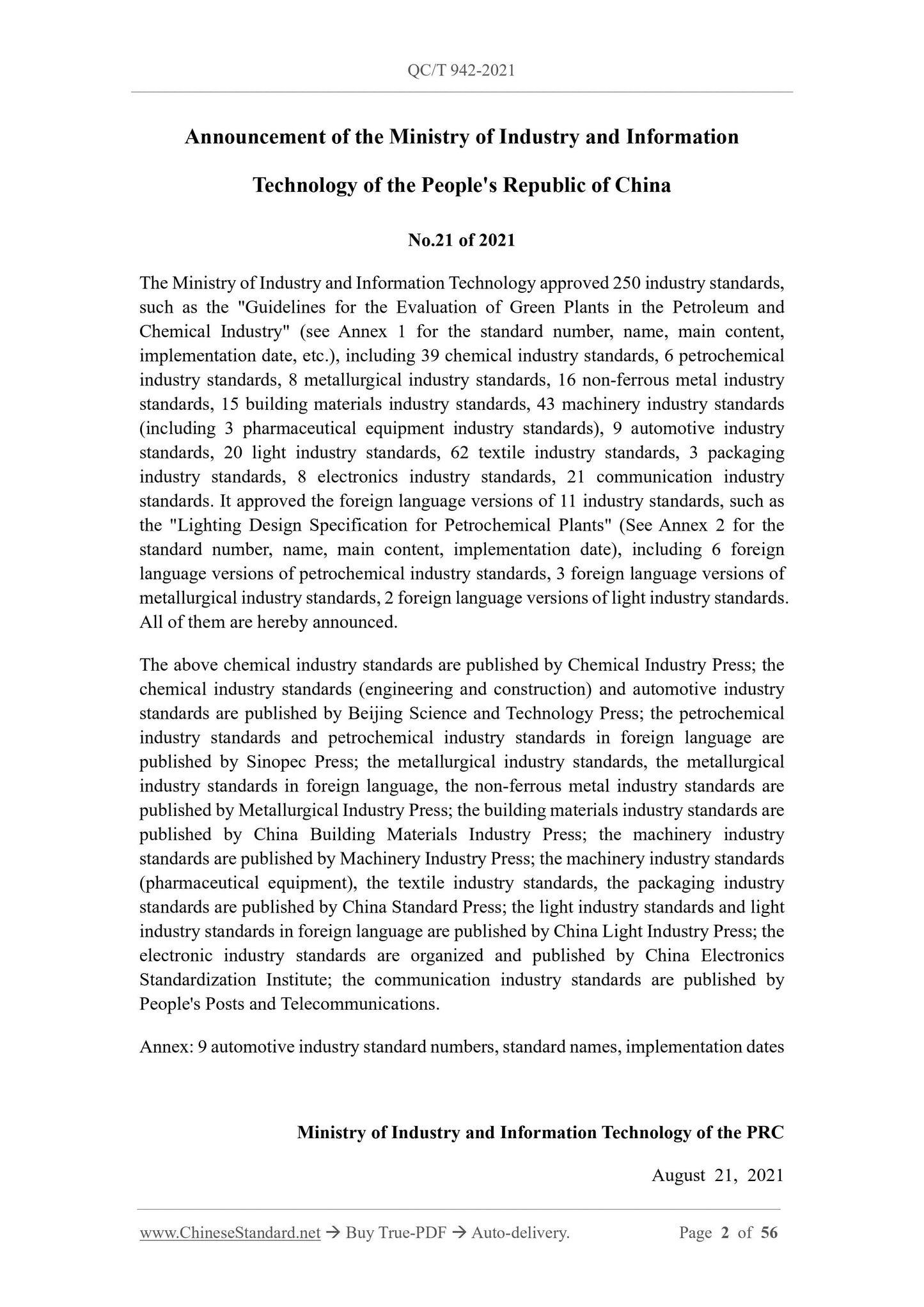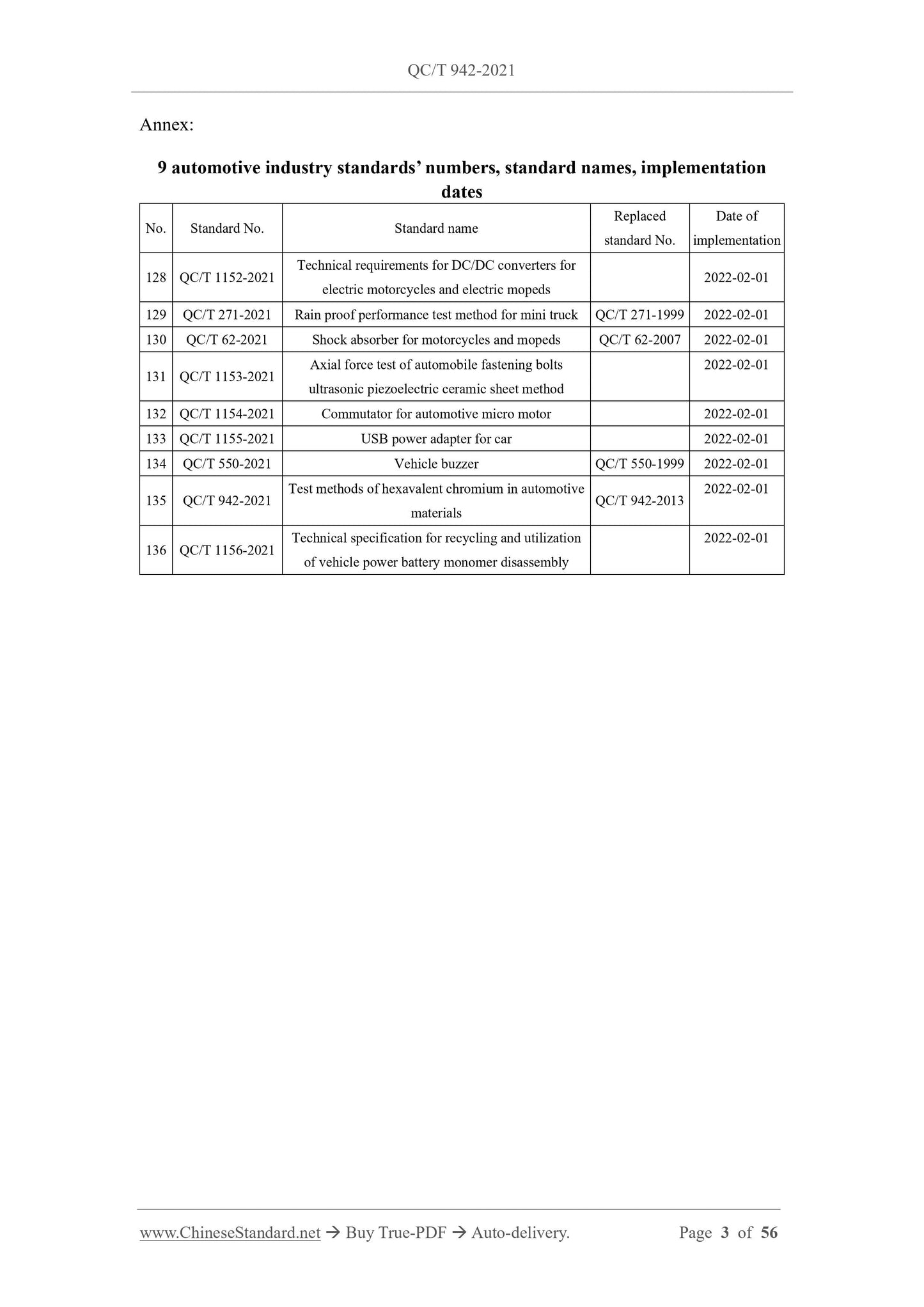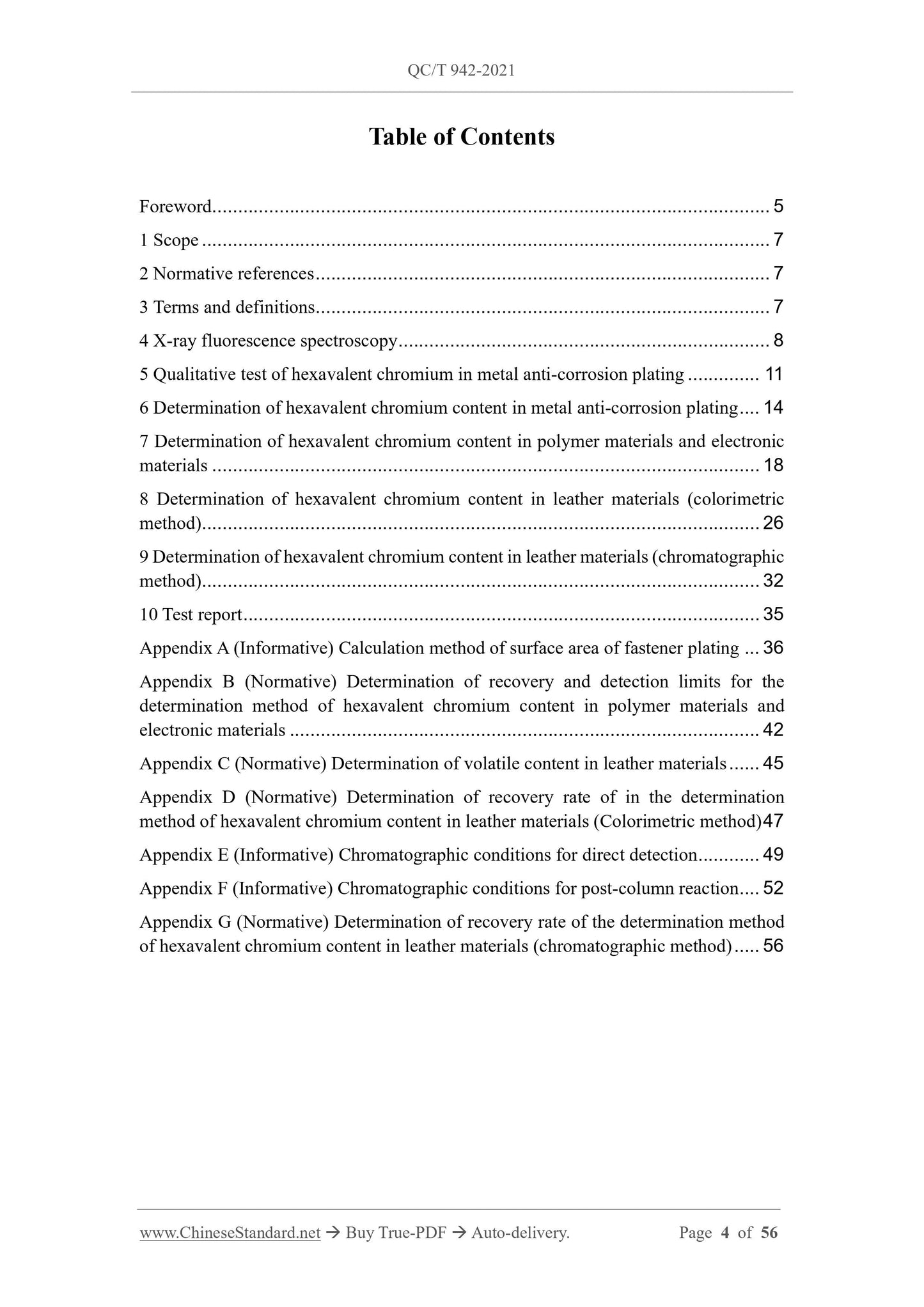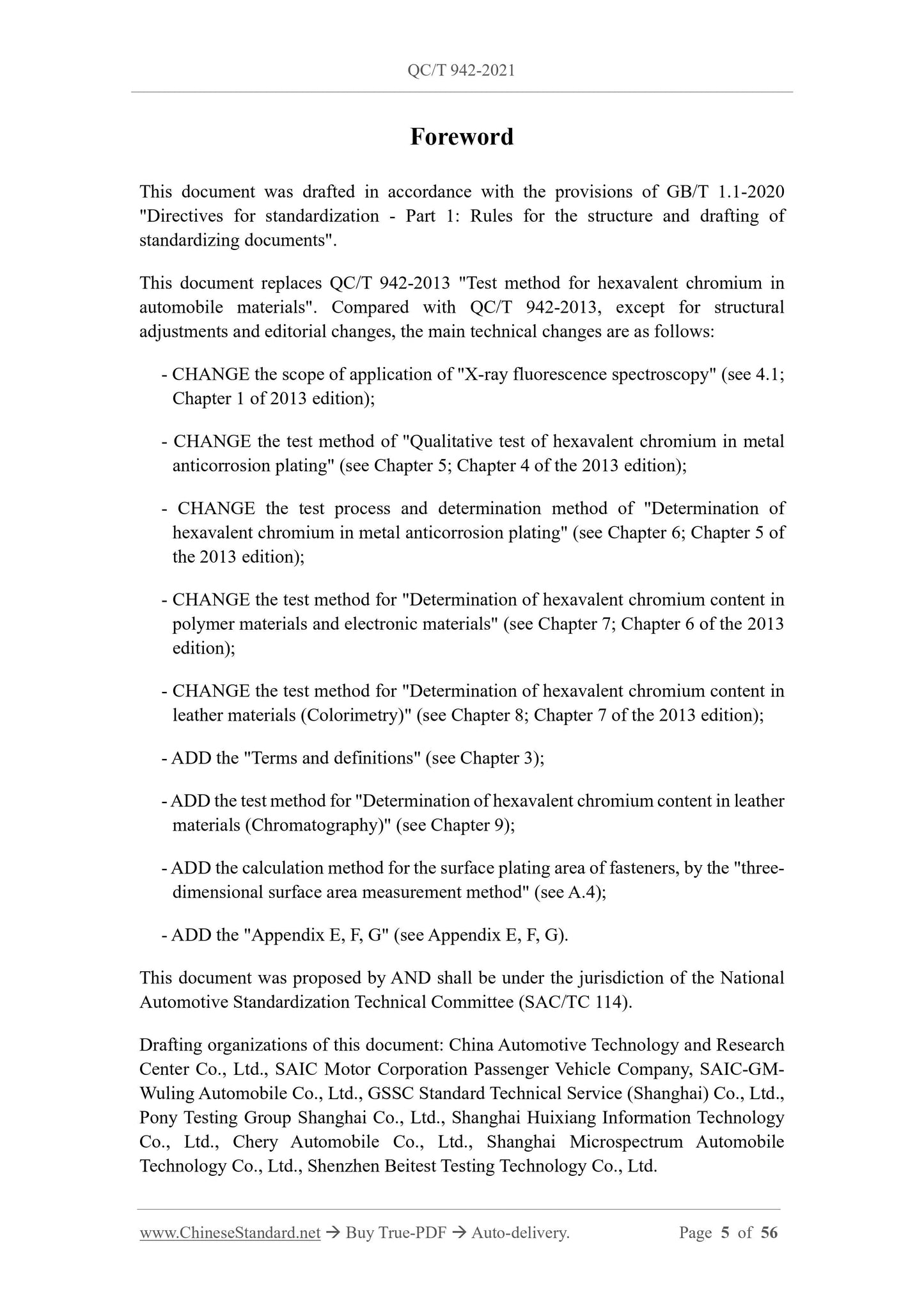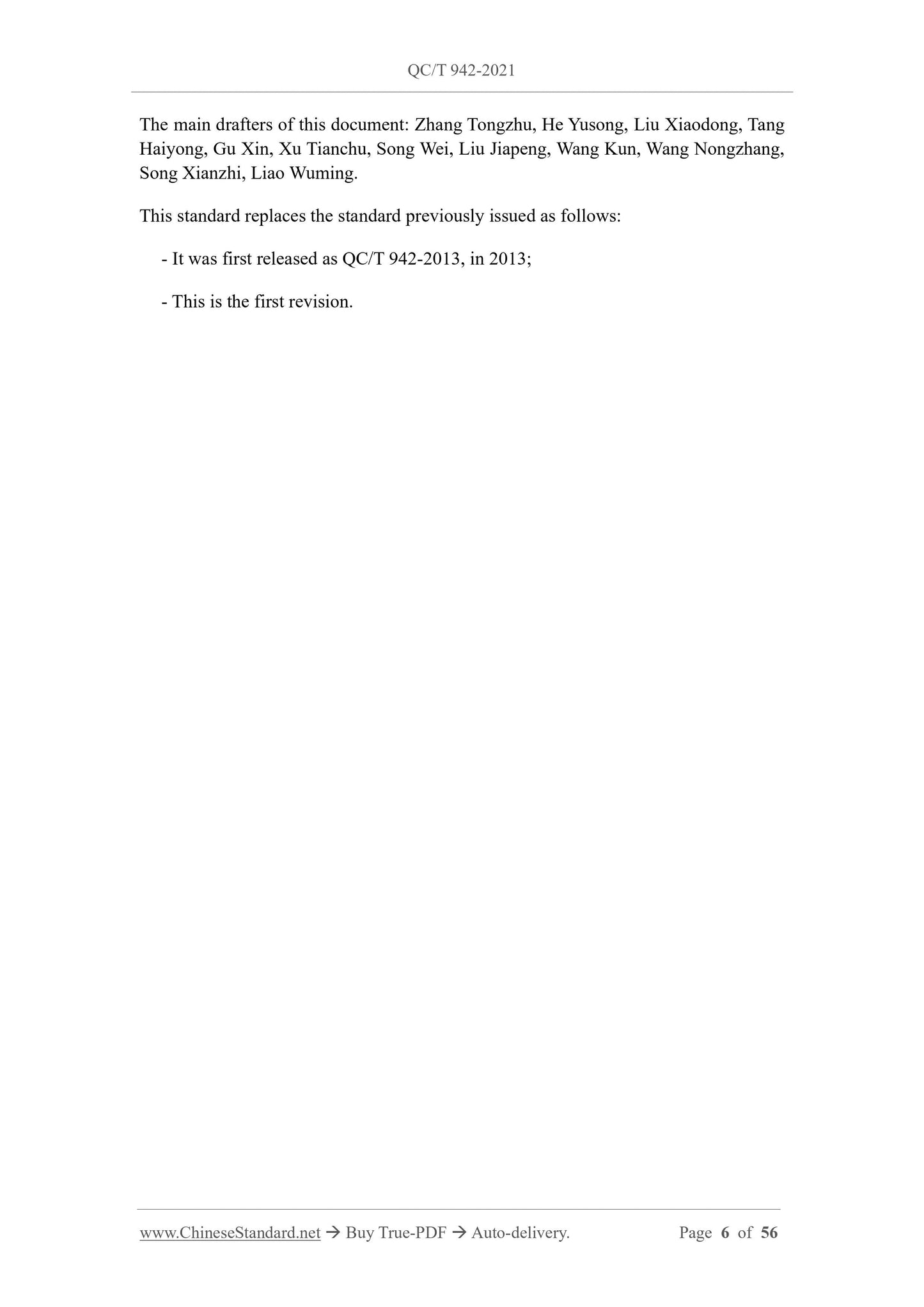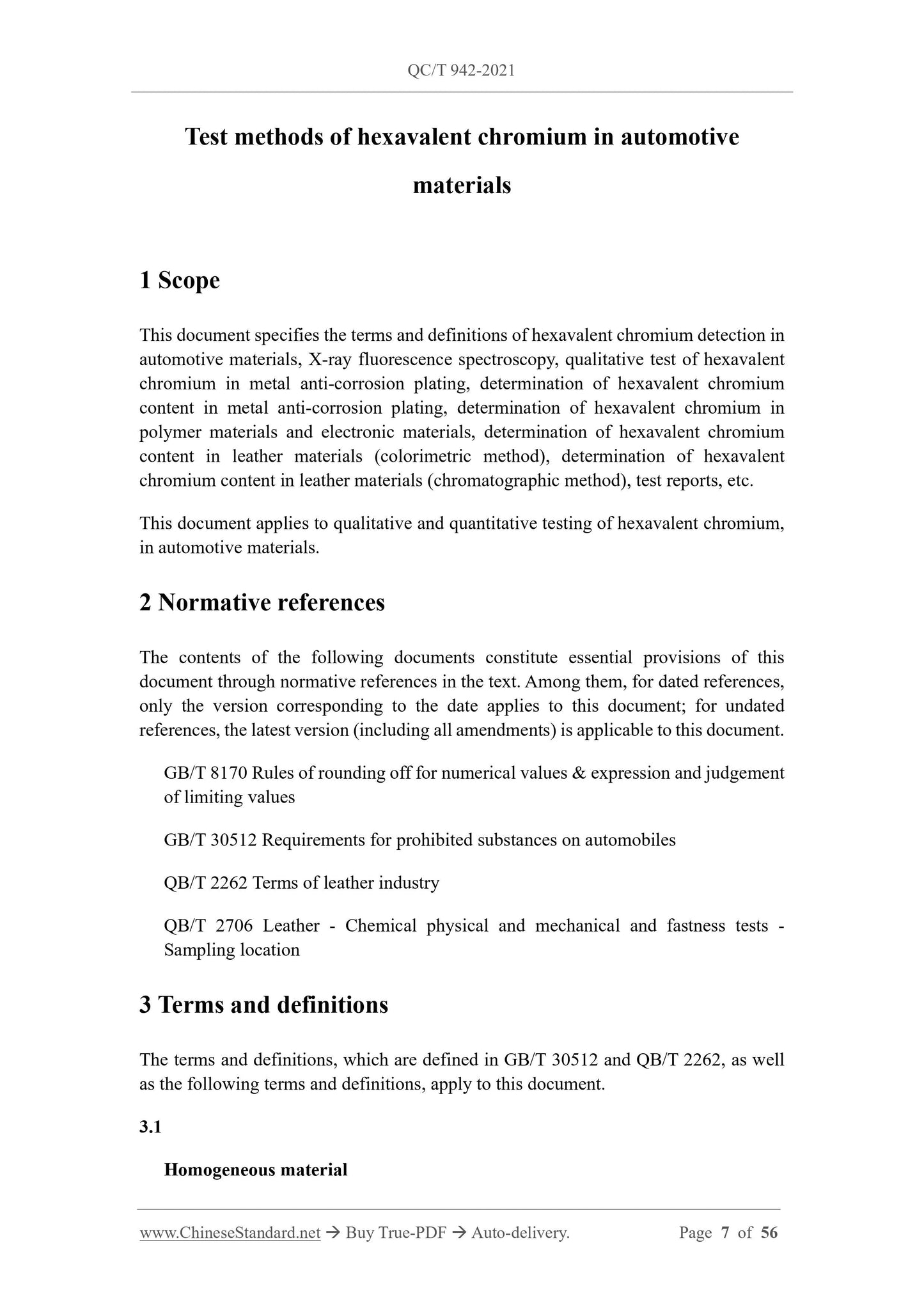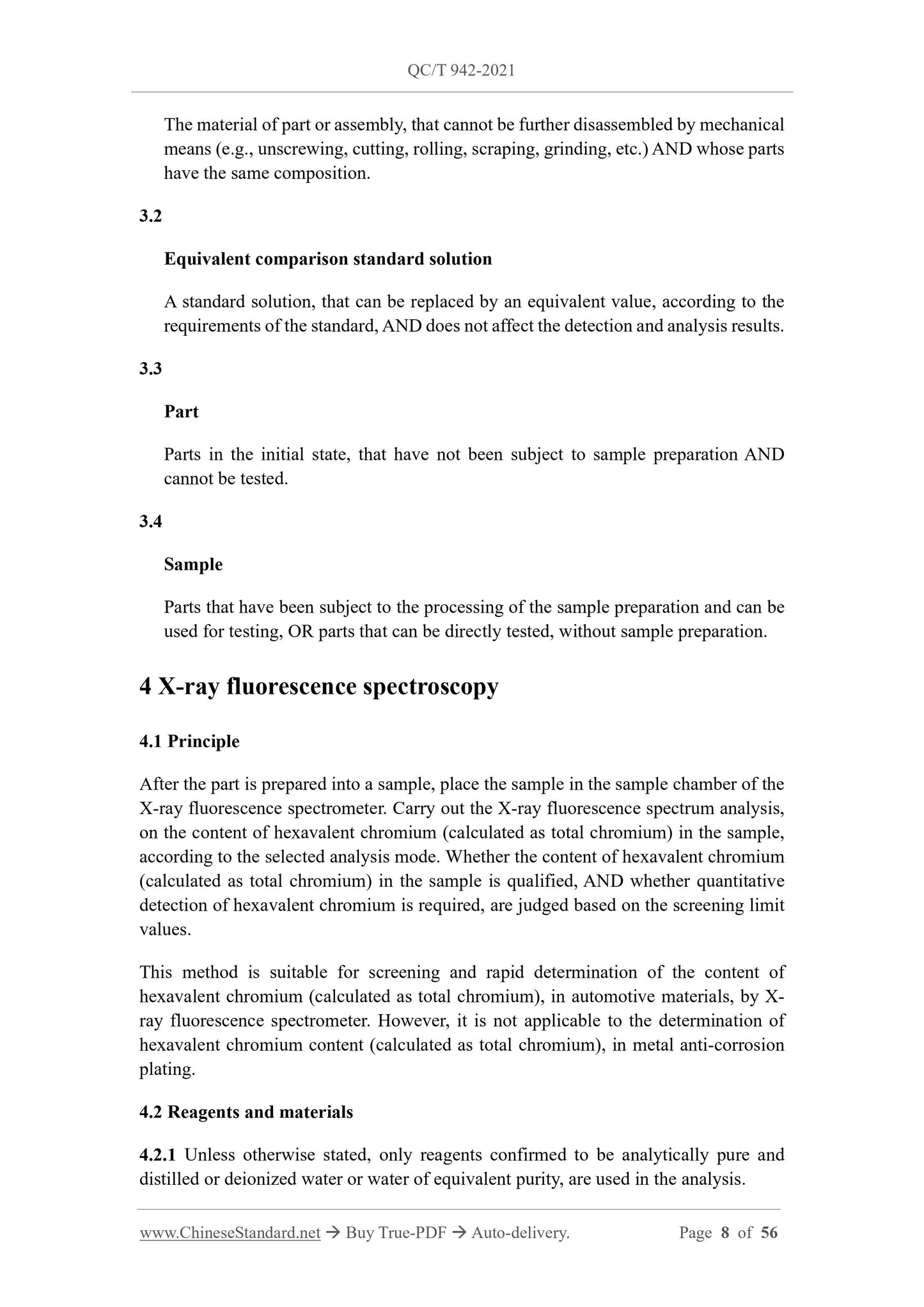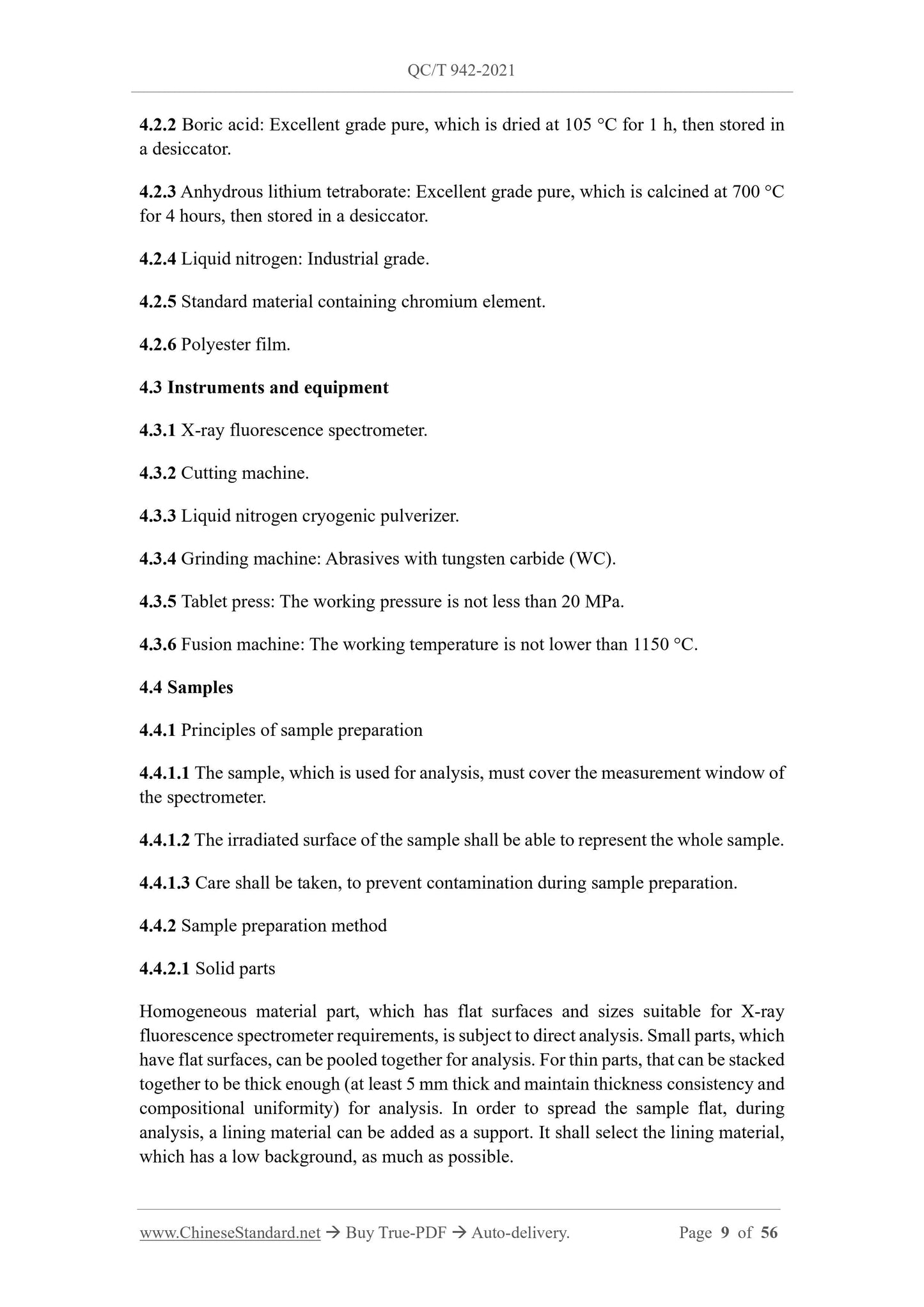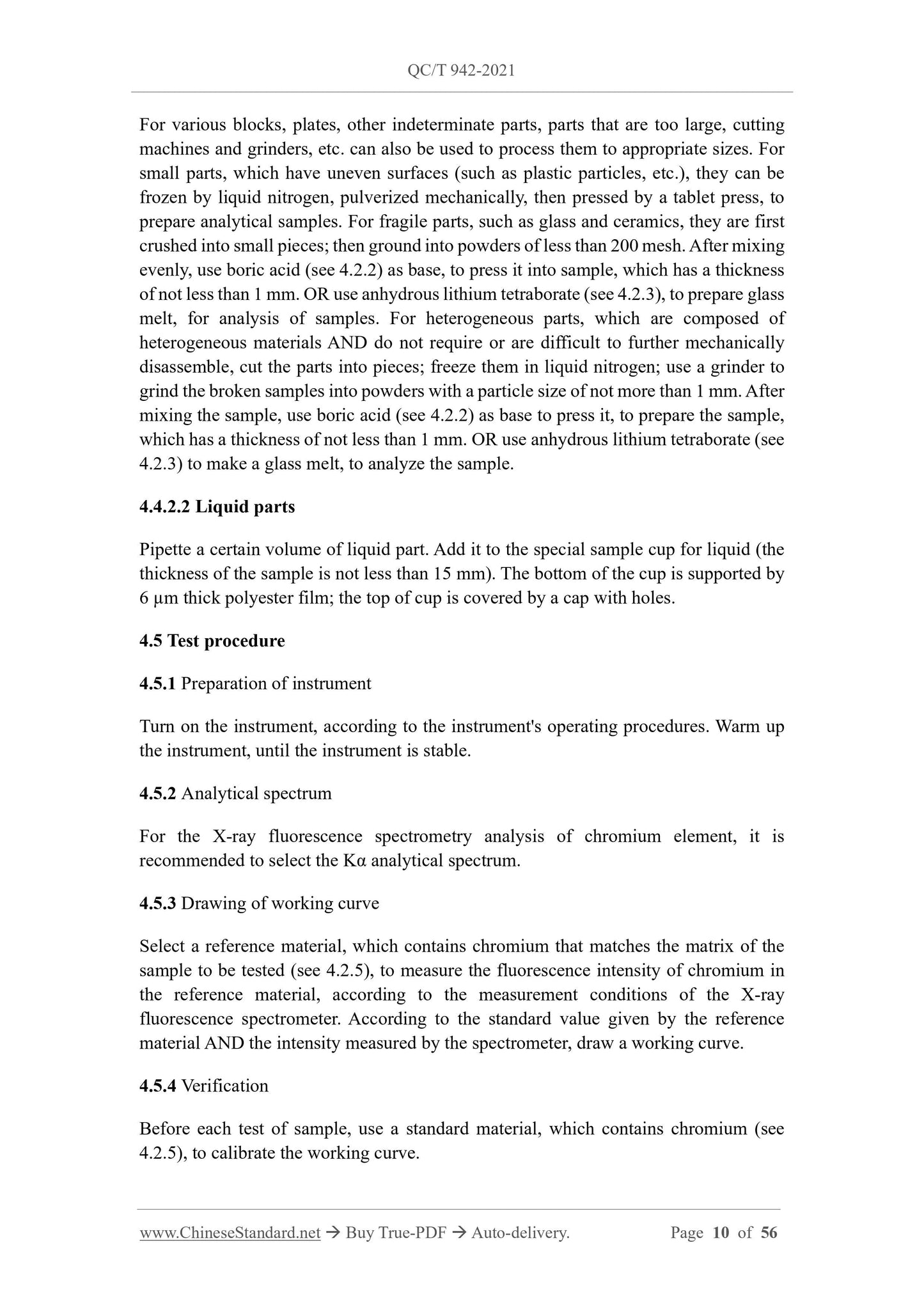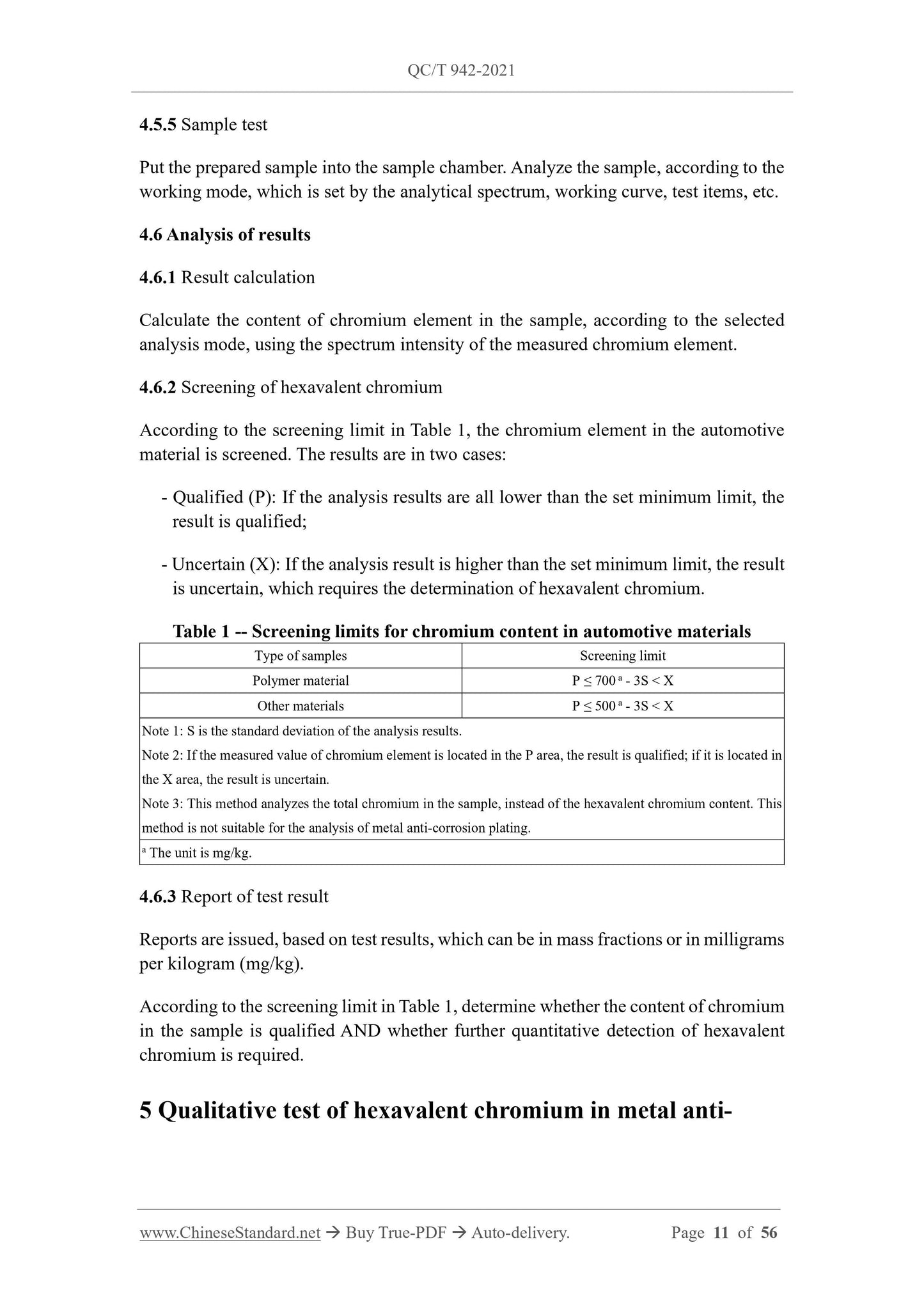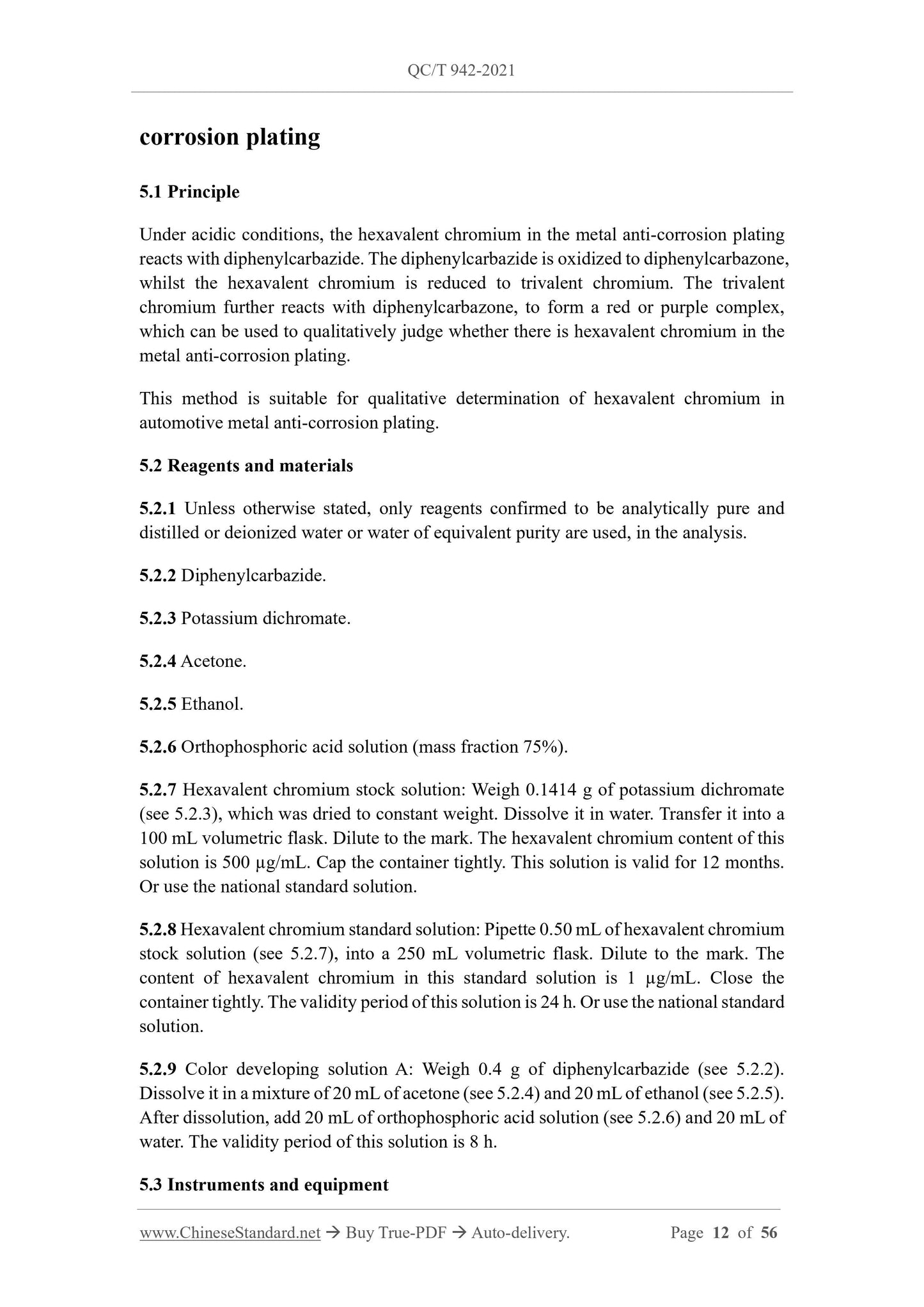1
/
su
12
PayPal, credit cards. Download editable-PDF & invoice in 1 second!
QC/T 942-2021 English PDF (QCT942-2021)
QC/T 942-2021 English PDF (QCT942-2021)
Prezzo di listino
$560.00 USD
Prezzo di listino
Prezzo scontato
$560.00 USD
Prezzo unitario
/
per
Spese di spedizione calcolate al check-out.
Impossibile caricare la disponibilità di ritiro
Delivery: 3 seconds. Download true-PDF + Invoice.
Get QUOTATION in 1-minute: Click QC/T 942-2021
Historical versions: QC/T 942-2021
Preview True-PDF (Reload/Scroll if blank)
QC/T 942-2021: Test methods of hexavalent chromium in automotive materials
QC/T 942-2021
AUTOMOBILE INDUSTRY STANDARD
ICS 43.020
CCS T 04
Replacing QC/T 942-2013
Test methods of hexavalent chromium in automotive
materials
ISSUED ON. AUGUST 21, 2021
IMPLEMENTED ON. FEBRUARY 01, 2022
Issued by. Ministry of Industry and Information Technology of PRC
Table of Contents
Foreword... 5
1 Scope... 7
2 Normative references... 7
3 Terms and definitions... 7
4 X-ray fluorescence spectroscopy... 8
5 Qualitative test of hexavalent chromium in metal anti-corrosion plating... 11
6 Determination of hexavalent chromium content in metal anti-corrosion plating... 14
7 Determination of hexavalent chromium content in polymer materials and electronic
materials... 18
8 Determination of hexavalent chromium content in leather materials (colorimetric
method)... 26
9 Determination of hexavalent chromium content in leather materials (chromatographic
method)... 32
10 Test report... 35
Appendix A (Informative) Calculation method of surface area of fastener plating... 36
Appendix B (Normative) Determination of recovery and detection limits for the
determination method of hexavalent chromium content in polymer materials and
electronic materials... 42
Appendix C (Normative) Determination of volatile content in leather materials... 45
Appendix D (Normative) Determination of recovery rate of in the determination
method of hexavalent chromium content in leather materials (Colorimetric method) 47
Appendix E (Informative) Chromatographic conditions for direct detection... 49
Appendix F (Informative) Chromatographic conditions for post-column reaction... 52
Appendix G (Normative) Determination of recovery rate of the determination method
of hexavalent chromium content in leather materials (chromatographic method)... 56
Test methods of hexavalent chromium in automotive
materials
1 Scope
This document specifies the terms and definitions of hexavalent chromium detection in
automotive materials, X-ray fluorescence spectroscopy, qualitative test of hexavalent
chromium in metal anti-corrosion plating, determination of hexavalent chromium
content in metal anti-corrosion plating, determination of hexavalent chromium in
polymer materials and electronic materials, determination of hexavalent chromium
content in leather materials (colorimetric method), determination of hexavalent
chromium content in leather materials (chromatographic method), test reports, etc.
This document applies to qualitative and quantitative testing of hexavalent chromium,
in automotive materials.
2 Normative references
The contents of the following documents constitute essential provisions of this
document through normative references in the text. Among them, for dated references,
only the version corresponding to the date applies to this document; for undated
references, the latest version (including all amendments) is applicable to this document.
GB/T 8170 Rules of rounding off for numerical values and expression and judgement
of limiting values
GB/T 30512 Requirements for prohibited substances on automobiles
QB/T 2262 Terms of leather industry
QB/T 2706 Leather - Chemical physical and mechanical and fastness tests -
Sampling location
3 Terms and definitions
The terms and definitions, which are defined in GB/T 30512 and QB/T 2262, as well
as the following terms and definitions, apply to this document.
3.1
Homogeneous material
4.2.2 Boric acid. Excellent grade pure, which is dried at 105 °C for 1 h, then stored in
a desiccator.
4.2.3 Anhydrous lithium tetraborate. Excellent grade pure, which is calcined at 700 °C
for 4 hours, then stored in a desiccator.
4.2.4 Liquid nitrogen. Industrial grade.
4.2.5 Standard material containing chromium element.
4.2.6 Polyester film.
4.3 Instruments and equipment
4.3.1 X-ray fluorescence spectrometer.
4.3.2 Cutting machine.
4.3.3 Liquid nitrogen cryogenic pulverizer.
4.3.4 Grinding machine. Abrasives with tungsten carbide (WC).
4.3.5 Tablet press. The working pressure is not less than 20 MPa.
4.3.6 Fusion machine. The working temperature is not lower than 1150 °C.
4.4 Samples
4.4.1 Principles of sample preparation
4.4.1.1 The sample, which is used for analysis, must cover the measurement window of
the spectrometer.
4.4.1.2 The irradiated surface of the sample shall be able to represent the whole sample.
4.4.1.3 Care shall be taken, to prevent contamination during sample preparation.
4.4.2 Sample preparation method
4.4.2.1 Solid parts
Homogeneous material part, which has flat surfaces and sizes suitable for X-ray
fluorescence spectrometer requirements, is subject to direct analysis. Small parts, which
have flat surfaces, can be pooled together for analysis. For thin parts, that can be stacked
together to be thick enough (at least 5 mm thick and maintain thickness consistency and
compositional uniformity) for analysis. In order to spread the sample flat, during
analysis, a lining material can be added as a support. It shall select the lining material,
which has a low background, as much as possible.
For various blocks, plates, other indeterminate parts, parts that are too large, cutting
machines and grinders, etc. can also be used to process them to appropriate sizes. For
small parts, which have uneven surfaces (such as plastic particles, etc.), they can be
frozen by liquid nitrogen, pulverized mechanically, then pressed by a tablet press, to
prepare analytical samples. For fragile parts, such as glass and ceramics, they are first
crushed into small pieces; then ground into powders of less than 200 mesh. After mixing
evenly, use boric acid (see 4.2.2) as base, to press it into sample, which has a thickness
of not less than 1 mm. OR use anhydrous lithium tetraborate (see 4.2.3), to prepare glass
melt, for analysis of samples. For heterogeneous parts, which are composed of
heterogeneous materials AND do not require or are difficult to further mechanically
disassemble, cut the parts into pieces; freeze them in liquid nitrogen; use a grinder to
grind the broken samples into powders with a particle size of not more than 1 mm. After
mixing the sample, use boric acid (see 4.2.2) as base to press it, to prepare the sample,
which has a thickness of not less than 1 mm. OR use anhydrous lithium tetraborate (see
4.2.3) to make a glass melt, to analyze the sample.
4.4.2.2 Liquid parts
Pipette a certain volume of liquid part. Add it to the special sample cup for liquid (the
thickness of the sample is not less than 15 mm). The bottom of the cup is supported by
6 µm thick polyester film; the top of cup is covered by a cap with holes.
4.5 Test procedure
4.5.1 Preparation of instrument
Turn on the instrument, according to the instrument's operating procedures. Warm up
the instrument, until the instrument is stable.
4.5.2 Analytical spectrum
For the X-ray fluorescence spectrometry analysis of chromium element, it is
recommended to select the Kα analytical spectrum.
4.5.3 Drawing of working curve
Select a reference material, which contains chromium that matches the matrix of the
sample to be tested (see 4.2.5), to measure the fluorescence intensity of chromium in
the reference material, according to the measurement conditions of the X-ray
fluorescence spectrometer. According to the standard value given by the reference
material AND the intensity measured by the spectrometer, draw a working curve.
4.5.4 Verification
Before each test of sample, use a st...
Get QUOTATION in 1-minute: Click QC/T 942-2021
Historical versions: QC/T 942-2021
Preview True-PDF (Reload/Scroll if blank)
QC/T 942-2021: Test methods of hexavalent chromium in automotive materials
QC/T 942-2021
AUTOMOBILE INDUSTRY STANDARD
ICS 43.020
CCS T 04
Replacing QC/T 942-2013
Test methods of hexavalent chromium in automotive
materials
ISSUED ON. AUGUST 21, 2021
IMPLEMENTED ON. FEBRUARY 01, 2022
Issued by. Ministry of Industry and Information Technology of PRC
Table of Contents
Foreword... 5
1 Scope... 7
2 Normative references... 7
3 Terms and definitions... 7
4 X-ray fluorescence spectroscopy... 8
5 Qualitative test of hexavalent chromium in metal anti-corrosion plating... 11
6 Determination of hexavalent chromium content in metal anti-corrosion plating... 14
7 Determination of hexavalent chromium content in polymer materials and electronic
materials... 18
8 Determination of hexavalent chromium content in leather materials (colorimetric
method)... 26
9 Determination of hexavalent chromium content in leather materials (chromatographic
method)... 32
10 Test report... 35
Appendix A (Informative) Calculation method of surface area of fastener plating... 36
Appendix B (Normative) Determination of recovery and detection limits for the
determination method of hexavalent chromium content in polymer materials and
electronic materials... 42
Appendix C (Normative) Determination of volatile content in leather materials... 45
Appendix D (Normative) Determination of recovery rate of in the determination
method of hexavalent chromium content in leather materials (Colorimetric method) 47
Appendix E (Informative) Chromatographic conditions for direct detection... 49
Appendix F (Informative) Chromatographic conditions for post-column reaction... 52
Appendix G (Normative) Determination of recovery rate of the determination method
of hexavalent chromium content in leather materials (chromatographic method)... 56
Test methods of hexavalent chromium in automotive
materials
1 Scope
This document specifies the terms and definitions of hexavalent chromium detection in
automotive materials, X-ray fluorescence spectroscopy, qualitative test of hexavalent
chromium in metal anti-corrosion plating, determination of hexavalent chromium
content in metal anti-corrosion plating, determination of hexavalent chromium in
polymer materials and electronic materials, determination of hexavalent chromium
content in leather materials (colorimetric method), determination of hexavalent
chromium content in leather materials (chromatographic method), test reports, etc.
This document applies to qualitative and quantitative testing of hexavalent chromium,
in automotive materials.
2 Normative references
The contents of the following documents constitute essential provisions of this
document through normative references in the text. Among them, for dated references,
only the version corresponding to the date applies to this document; for undated
references, the latest version (including all amendments) is applicable to this document.
GB/T 8170 Rules of rounding off for numerical values and expression and judgement
of limiting values
GB/T 30512 Requirements for prohibited substances on automobiles
QB/T 2262 Terms of leather industry
QB/T 2706 Leather - Chemical physical and mechanical and fastness tests -
Sampling location
3 Terms and definitions
The terms and definitions, which are defined in GB/T 30512 and QB/T 2262, as well
as the following terms and definitions, apply to this document.
3.1
Homogeneous material
4.2.2 Boric acid. Excellent grade pure, which is dried at 105 °C for 1 h, then stored in
a desiccator.
4.2.3 Anhydrous lithium tetraborate. Excellent grade pure, which is calcined at 700 °C
for 4 hours, then stored in a desiccator.
4.2.4 Liquid nitrogen. Industrial grade.
4.2.5 Standard material containing chromium element.
4.2.6 Polyester film.
4.3 Instruments and equipment
4.3.1 X-ray fluorescence spectrometer.
4.3.2 Cutting machine.
4.3.3 Liquid nitrogen cryogenic pulverizer.
4.3.4 Grinding machine. Abrasives with tungsten carbide (WC).
4.3.5 Tablet press. The working pressure is not less than 20 MPa.
4.3.6 Fusion machine. The working temperature is not lower than 1150 °C.
4.4 Samples
4.4.1 Principles of sample preparation
4.4.1.1 The sample, which is used for analysis, must cover the measurement window of
the spectrometer.
4.4.1.2 The irradiated surface of the sample shall be able to represent the whole sample.
4.4.1.3 Care shall be taken, to prevent contamination during sample preparation.
4.4.2 Sample preparation method
4.4.2.1 Solid parts
Homogeneous material part, which has flat surfaces and sizes suitable for X-ray
fluorescence spectrometer requirements, is subject to direct analysis. Small parts, which
have flat surfaces, can be pooled together for analysis. For thin parts, that can be stacked
together to be thick enough (at least 5 mm thick and maintain thickness consistency and
compositional uniformity) for analysis. In order to spread the sample flat, during
analysis, a lining material can be added as a support. It shall select the lining material,
which has a low background, as much as possible.
For various blocks, plates, other indeterminate parts, parts that are too large, cutting
machines and grinders, etc. can also be used to process them to appropriate sizes. For
small parts, which have uneven surfaces (such as plastic particles, etc.), they can be
frozen by liquid nitrogen, pulverized mechanically, then pressed by a tablet press, to
prepare analytical samples. For fragile parts, such as glass and ceramics, they are first
crushed into small pieces; then ground into powders of less than 200 mesh. After mixing
evenly, use boric acid (see 4.2.2) as base, to press it into sample, which has a thickness
of not less than 1 mm. OR use anhydrous lithium tetraborate (see 4.2.3), to prepare glass
melt, for analysis of samples. For heterogeneous parts, which are composed of
heterogeneous materials AND do not require or are difficult to further mechanically
disassemble, cut the parts into pieces; freeze them in liquid nitrogen; use a grinder to
grind the broken samples into powders with a particle size of not more than 1 mm. After
mixing the sample, use boric acid (see 4.2.2) as base to press it, to prepare the sample,
which has a thickness of not less than 1 mm. OR use anhydrous lithium tetraborate (see
4.2.3) to make a glass melt, to analyze the sample.
4.4.2.2 Liquid parts
Pipette a certain volume of liquid part. Add it to the special sample cup for liquid (the
thickness of the sample is not less than 15 mm). The bottom of the cup is supported by
6 µm thick polyester film; the top of cup is covered by a cap with holes.
4.5 Test procedure
4.5.1 Preparation of instrument
Turn on the instrument, according to the instrument's operating procedures. Warm up
the instrument, until the instrument is stable.
4.5.2 Analytical spectrum
For the X-ray fluorescence spectrometry analysis of chromium element, it is
recommended to select the Kα analytical spectrum.
4.5.3 Drawing of working curve
Select a reference material, which contains chromium that matches the matrix of the
sample to be tested (see 4.2.5), to measure the fluorescence intensity of chromium in
the reference material, according to the measurement conditions of the X-ray
fluorescence spectrometer. According to the standard value given by the reference
material AND the intensity measured by the spectrometer, draw a working curve.
4.5.4 Verification
Before each test of sample, use a st...
Share
